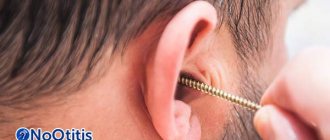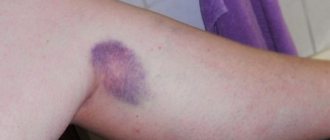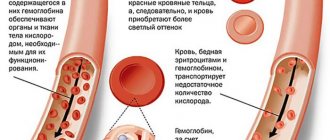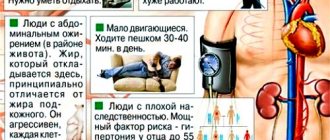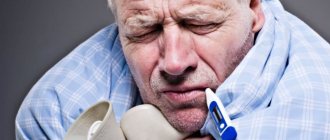Tachycardia with VSD occurs quite often; this is manifested by the fact that the patient feels a pulse of more than 90 beats per minute. It occurs when a person is in a calm state, because during physical activity, an accelerated heartbeat is considered normal.
If it happens that there is a suspicion of tachycardia, then you need to contact a medical institution. After all, a person’s normal pulse should be from 60 to 80 beats. An attack may occur when the patient is calm, which indicates that tachycardia during VSD is most likely a concern.
Main reasons
With VSD, tachycardia is often observed and this can occur for several reasons. In order to determine whether an attack has occurred, it is necessary to measure the pulse; it should be no more than 80 beats per minute in a calm state. Tachycardia can occur suddenly and last from a minute to several days.
An attack can occur due to several reasons:
- constant fatigue;
- lack of sleep;
- frequent stressful situations;
- depression;
- consumption of alcoholic beverages and tobacco products;
- poor nutrition;
- exhaustion of the body;
- hormonal imbalance.
Experts say that for the most part, diseases associated with the cardiovascular system arise due to stress. If the patient leads a sedentary lifestyle, this leads to tachycardia during VSD. If you do not seek help from a medical facility, the consequences can be serious.
An increased heart rate can lead to dizziness, nausea and shortness of breath. If treatment is not prescribed, over time it will cause heart failure. In order to avoid any complications, you should visit a doctor at the first signs.
Types of seizures
Why does your Yorkie tremble at home and stick out its tongue: reasons
It happens that a dog's fainting is accompanied by convulsions or they precede loss of consciousness. Some of them are not dangerous, others require immediate attention to a veterinarian.
The following types of seizures are distinguished:
- convulsions. It is not always easy to notice them; the dog’s paws twitch slightly. In this case, the animal is usually conscious and responds to the owner’s voice;
- tonic convulsions. Muscles contract after a certain period of time. The dog feels discomfort and even pain, so it may whine;
- clonic convulsions. The muscles tense and then relax. The time interval between convulsions can vary: from 30 seconds. up to a couple of minutes. The dog has difficulty controlling its body at the moment of muscle tension and may fall on its side;
- epileptic seizures. The pet's condition resembles a seizure. He cannot move, he is constantly tense. His body relaxes for only a few seconds, and then the muscles spasm again. He is unconscious, his eyes are rolling back. However, they are not necessarily closed. This condition is dangerous for the dog and requires medical attention.
Classification of the disease and complications
Attacks of tachycardia can occur suddenly and last from a minute to two days. VSD can occur not only in the form of an increase in heart rate. Supraventricular tachycardia manifests itself in that it can reach up to 200 beats per minute . The patient feels such changes sharply, but this does not pose any danger to the person. But the patient feels that the emotional background is suffering and this brings discomfort.
Constant tachycardia with it the pulse does not increase 120 beats per minute. The patient most often practically does not notice that he has an increased heart rate. The disease develops slowly, so it is difficult for the patient to understand what is bothering him. The rhythm is lost and blood pressure may increase.
Sinus tachycardia the pulse can increase to 135 beats per minute. This is most often a concern for young people. If a person can easily tolerate such disorders, then this is considered a normal condition.
If tachycardia with VSD bothers you for a long time, then this will not only lead to changes in internal organs, but can also drive you into a depressive state. During an attack, the patient may feel panic and fear of death.
If frequent attacks occur, there is a strain on the heart and blood vessels. An increase in pressure may occur and this puts stress on the myocardium. If the patient suffers from ischemia, this can lead to a heart attack. It is best to consult a doctor at the first symptoms.
Diagnosis of heart disease
To make an accurate diagnosis, a comprehensive examination is required. The veterinarian prescribes a number of procedures.
Analyzes
A urine test will provide an opportunity to assess the condition of the liver. Blood tests are taken to identify possible infections, determine the condition of the kidneys and liver, and the thyroid gland.
X-ray
The procedure is prescribed when a frequent cough occurs. Thanks to it, it is possible to assess the condition of the heart and lungs, determine whether there is fluid and formations around the organs.
Ultrasound
With the help of ultrasound, it is possible to obtain the most complete picture of the condition of vital organs and find out the extent of the lesion.
ECG
This test measures your heart rate and counts your heart's electrical impulses.
First aid for tachycardia
It is impossible to completely recover from tachycardia with VSD. First of all, as soon as the attack begins, you need to follow some rules to alleviate the condition. You need to lie down and unbutton your shirt so that your neck is free. Next, wash your face with cool water and place a cold cloth on your forehead.
If nausea bothers you, you should try to cough. Open the window to allow fresh air into the room. Do breathing exercises, you need to take a deep breath and exhale quickly for about five minutes.
You need to take about 20-30 drops of Corvalol. If after 10 minutes it does not feel better and the pulse does not drop, you need to call emergency medical services. If you do not go to a medical facility, this can lead to a heart attack or stroke. The doctor will prescribe a comprehensive examination and effective treatment.
What should the owner do?
If a dog faints, the owner should not panic. You need to provide first aid:
- Remove all pressure objects and clothing. Harnesses, leashes, and muzzles can worsen the condition.
- It is advisable to place the animal on its side, especially if it has been vomiting. In this case, it is necessary to clear the animal’s mouth of food debris and wipe its face. While the dog is unconscious, there is no need to give him water. As soon as he comes to his senses and can lap, give cool water.
- The head should be lower than the body, which will ensure blood flow to it.
- If your pet becomes ill in the heat, use a damp bandage. A cold compress can be placed under the head. If the dog is cold, warm it up, first of all with its paws. If you don't have a heating pad on hand, you can use a bottle filled with warm water.
- Make sure that the tongue does not fall inside. If possible, it's better to pull it out.
Coordinated actions are required from the owner
Note! After the dog has regained consciousness, you need to go to the veterinarian to rule out the presence of dangerous diseases. If possible, call a doctor home so as not to disturb the animal again.
Treatment
Treatment is to eliminate the palpitations. Drug therapy, massage procedures, and healing baths are used. Tachycardia with VSD is most often treated with sedatives and other drugs.
The following medications are prescribed:
- Medicines that contain natural ingredients: hawthorn, lemon balm, motherwort, they calm well and relieve nervous tension. Such herbal preparations have virtually no contraindications, so they can be used for a long time. Medicines with natural composition are available without a prescription.
- The sedatives Prazepam and Relanum contain chemical compounds. Such remedies give positive results in the treatment of stressful situations. There are a number of side effects, but they calm well, so attacks of tachycardia become less frequent. Almost all such drugs must be prescribed by a doctor and are available with a prescription.
- Antiarrhythmic medications are used to treat tachycardia. They help normalize the heartbeat and reduce attacks of the disease. The drugs have a number of contraindications.
All of the above medications can only be prescribed by a doctor. It all depends on how advanced the disease is. Drugs with antiarrhythmic action help to eliminate attacks of tachycardia during VSD.
The following groups of drugs are used:
- Beta-blockers Betoftan, Niolol, Obzidan significantly reduce the effect of adrenaline. They help normalize blood pressure and heart rate. A side effect may be bronchospasm.
- Potassium channel blockers Amiodarone prevent the element from entering the heart, therefore blood pressure and tachycardia decrease. The drug has few contraindications and is used in the treatment of arrhythmia and high blood pressure. If the medicine is used for a long time, there may be side effects in the form of weakness, decreased vision and disruptions in the thyroid gland.
Drug therapy will only help temporarily eliminate the symptoms of tachycardia during VSD. The specialist can prescribe the patient to visit a psychotherapist, this can bring positive results in treatment. An experienced psychologist will help improve the emotional state of the patient.
A person may feel improvement after just five visits to a psychotherapist. It is best to complete the full course of treatment, which is at least 10 sessions. During this time, the doctor reduces various factors that affect the patient’s psychological state. If the disease is already in an advanced form, then it is best to use medications. In order to prevent the disease from progressing, it is necessary to visit a medical facility on time.
Risk factors
Among the factors that provoke tachycardia are endocrinological problems, diseases of the cardiovascular and respiratory systems. Pregnant and lactating females suffering from endometriosis or mastitis may experience abnormal heart rates.
There are predisposed breeds that are more susceptible to the disease than other dogs. Large breeds include Great Danes, Alabais, St. Bernards, and Newfoundlands.
Small breed dogs often suffer from increased nervous excitability, which is the cause of heart disorders. These are Pekingese, Chihuahuas, Yorkshire terriers and others.
Service and hunting dogs whose lives involve heavy physical exertion and are full of stress are susceptible to tachycardia.
Dogs leading a passive lifestyle can also experience heart rhythm disturbances at the slightest exertion, since they are not at all accustomed to them.
Traditional methods of treatment
Strong heartbeats can be blocked using traditional methods of treatment. They have no side effects and are not addictive. There are practically no contraindications, so traditional medicine is a good choice for patients who cannot take medications.
Recipe preparation methods:
- Tea made from Sudanese rose in a simple hibiscus style has a pleasant aroma. Well calms and reduces heart attacks. In order to prepare, you need to take a few buds and pour a glass of hot water. You can drink no more than two cups of tea per day.
- Collections of medicinal herbs can be easily purchased at the pharmacy stall. They help to calm down and normalize blood pressure. To prepare, you need to take the ingredients and pour boiling water. You need to take about 50 ml orally 4-5 times a day.
- Tincture of valerian and calendula, take the ingredients one spoon at a time and add hot water. Leave for about an hour and consume 50 ml three times a day. You need to take it for at least two weeks, then take a break and repeat the dose.
- Hawthorn helps eliminate high blood pressure and normalize high heart rate. In order to prepare a decoction, you need to take the plant and add hot water. Leave for about twenty minutes and drink half a glass every morning and evening.
Honey brings good results in treatment; it should be eaten several times a day, a teaspoon. Before choosing traditional methods of therapy, you need to consult a doctor. Some drugs are incompatible with traditional medicine.
Is a person with high heart rate at risk?
Infrequent attacks of tachycardia in dystonics, as a rule, do not pose a threat to life. Often they even serve as a kind of training for the heart muscle, which bears fruit in old age. The heart of a VSD student turns out to be healthy beyond his years. But still, the heart muscle is not a robotic mechanism, and frequent tachycardia states have their negative consequences. Therefore, it is advisable to treat the symptom rather than let it take its course. What happens if you don't get treatment?
- The heart will begin to wear out, age prematurely, and will not be able to fully cope with its work - and this will affect the entire body.
- The quality of life decreases, the person begins to experience shortness of breath and dizziness.
- The myocardium will undergo hypertrophy - this is fraught with the risk of a heart attack in the future.
- Early heart failure may develop.
- Frequent heartbeat impairs the supply of oxygen to the brain and body, and this affects a person’s well-being and performance.
Before making a decision, it is still advisable to undergo a full medical examination and find out the true causes of rapid heartbeat. And then everything depends on your efforts.
Preventive measures
If you follow preventive measures for VSD, this will not only help avoid tachycardia, but also other diseases. You need to make time for sleep and sleep at least eight hours. If you have a sedentary job, then you need to get up and do a light warm-up more often. Eat only high-quality and healthy food. Eat more fresh fruits and vegetables.
Try to avoid stressful situations, as all diseases arise from this. Avoid alcoholic drinks and cigarettes. People of all ages should take care of their health.
After 45 years, the cardiovascular system can suffer greatly due to stress and other reasons. In order to avoid any unpleasant pathologies, you need to lead a healthy lifestyle.
Spend more time in the fresh air and eat only healthy foods. If you stop being nervous, you can easily get rid of VSD. You can add dried fruits, nuts, and fish to your diet. If you have extra pounds, then you need to lose weight, but this should be done gradually so as not to harm the body.
The disease occurs frequently; it may be due to various disruptions in the nervous system. If tachycardia during VSD is mild, then treatment is not required. It is best to find pathology immediately to prevent complications.
Medicines and folk methods will help reduce a high pulse and normalize the emotional background. Only a doctor should prescribe treatment, since the drugs have a number of side effects. Tachycardia and VSD have a close relationship. It is not recommended to neglect the disease, as this can even lead to severe depression.
Possible causes of fainting in dogs
There may be several reasons why a dog faints. This happens even from an excess of emotions, severe fear or excessive happiness. Rarely, dogs lose consciousness when meeting their owner, from whom they suffered from a long separation and missed her greatly.
Fainting dog
For your information! A loud bang or explosion can frighten and deafen your pet, resulting in loss of consciousness. Small dogs, for example, should not be taken to noisy celebrations accompanied by fireworks and fireworks. For them, a large crowd of people is already a huge stress.
The animal may faint from overheating or hypothermia. You should always monitor weather conditions and make sure your pet is comfortable. A dog can pass out from the heat, whether it's a puppy or an old dog. The scorching sun is dangerous for all animals, especially furry ones and pets with black fur. Therefore, in the summer, many people prefer to cut their pets' hair, even if this makes them lose their attractiveness. Frostbite usually starts from the extremities; it is the paws that freeze first. No less dangerous is the sudden movement of a pet from the cold to a hot and stuffy room. Changes in temperature can negatively affect its condition.
The following can also cause a dog to faint:
- lack of nutrients, systematic malnutrition;
- poisoning;
- wound or other serious injury accompanied by large loss of blood;
- prolonged stay in moving vehicles, especially without access to fresh air.
Note! There was a recorded case where a dog pretended to faint. She tried to avoid having her nails trimmed, and as soon as her owner approached her with a tool, she fell on her side.
The most dangerous reason for a dog to faint is problems with the heart or blood vessels. After such an incident, the dog should be shown to a doctor in any case, even if there is confidence that this happened due to the heat and the animal felt better. Only a specialist can assess the dog’s condition and determine the true cause of the illness.
Visit to the veterinarian
